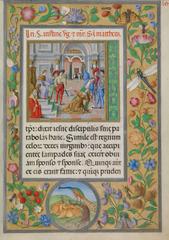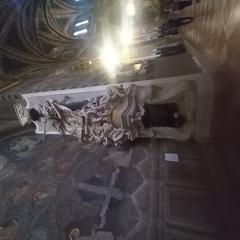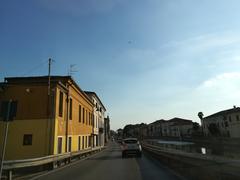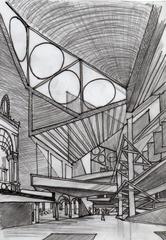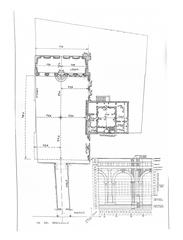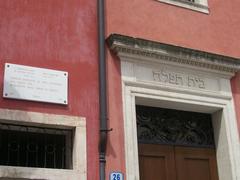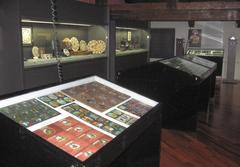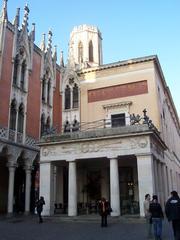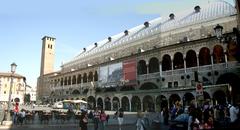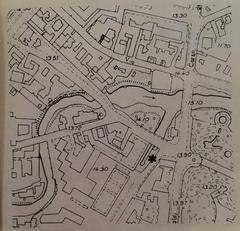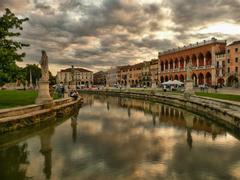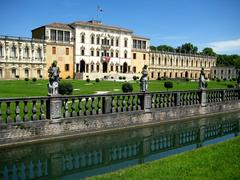Padova Botanical Garden: Visiting Hours, Tickets, and Your Guide to Padua’s Historic Green Sanctuary
Date: 14/06/2025
Introduction
Nestled in the heart of Padua, Italy, the Padova Botanical Garden (Orto Botanico di Padova) is a living testament to centuries of botanical science, Renaissance artistry, and educational innovation. Established in 1545, it is the world’s oldest academic botanical garden still in its original location and has been recognized as a UNESCO World Heritage Site for its pivotal role in the advancement of plant studies. With a collection of over 6,000 specimens, rare historical trees, and modern greenhouses, the garden offers visitors an immersive journey through the evolution of botanical knowledge and conservation. This guide provides comprehensive information about visiting hours, tickets, accessibility, and nearby Padua historical sites to ensure an enriching and memorable experience (Padova.com, Orto Botanico 1545, Attractive Italy).
Historical Overview
Origins and Foundation
The Padova Botanical Garden was established by the Venetian Republic to serve the University of Padua’s Faculty of Medicine, marking a groundbreaking shift from medieval herbal traditions to empirical botanical research. Situated on former monastic land, the garden was originally conceived as an “Horto Medicinale” for the cultivation and study of medicinal plants. Its creation is credited to Francesco Bonafede, with architectural input from Andrea Moroni, and its geometric design—a circle within a square, divided into quadrants—reflects the Renaissance pursuit of harmony between art, science, and nature (Padova.com, Turismo Padova).
Renaissance Layout and Scientific Influence
The garden’s original “Hortus Sphaericus” features a central fountain, marble basins, and four pathways aligned with the cardinal points. This innovative layout facilitated a systematic approach to plant classification and medicine, inspiring the design of botanical gardens throughout Europe. Statues, historic trees, and a Renaissance wall—built to protect rare plant species—add to the garden’s unique character (Attractive Italy).
Over the centuries, the Padova Botanical Garden expanded its plant collections through Venetian trade routes, introducing species such as the sunflower, potato, and Himalayan cedar. The garden’s library houses more than 50,000 volumes, and its herbarium is the second largest in Italy (Padova.com).
Notable Historical Specimens
Among its many living treasures are the Mediterranean dwarf palm—famously admired by Goethe—an Old World Sycamore from 1680, a Ginkgo biloba dating to 1750, and one of Europe’s oldest Southern Magnolias. The Botanical Theatre, a Renaissance lecture space, and the historic greenhouses further exemplify the garden’s enduring educational mission (My Italian Diaries).
Modernization and Biodiversity
The garden’s commitment to scientific progress continues with the Biodiversity Garden, inaugurated in 2014. This modern extension features themed greenhouses simulating tropical, temperate, arid, and Mediterranean biomes, and spotlights the impact of climate change and the importance of plant conservation (Orto Botanico 1545).
UNESCO World Heritage Recognition
In 1997, the Padova Botanical Garden was inscribed as a UNESCO World Heritage Site for its outstanding scientific legacy and influence on the development of botanical gardens worldwide (Padova.com).
Visitor Information: Hours, Tickets, and Practical Details
Location and Access
- Address: Via Orto Botanico, 15, 35123 Padova PD, Italy
- Situated between Prato della Valle and the Basilica of St. Anthony, the garden is easily accessible on foot from the city center. Public transport (bus lines 6 and 11) stops nearby, and limited parking is available in the vicinity (Viaggiando Italia).
Visiting Hours
- March to October: 9:00 AM – 7:00 PM (last admission 6:30 PM)
- November to February: 9:00 AM – 5:00 PM (last admission 4:30 PM)
- Closed: Mondays and public holidays (check the official website for holiday variations and updates)
Ticket Prices
- Adults: €8–€10 (varies by season and events)
- Reduced: €5–€7 (students, seniors)
- Children: Free for children under 6 or 14 (see current policy)
- Guided Tours: Available by reservation for an additional fee
- Where to Buy: Tickets can be purchased online via the official website or at the garden entrance.
Accessibility
- Wheelchair accessible with paved paths and ramps throughout the main areas.
- Restrooms, a bookshop, café, and assistance are available.
- Audio guides (including child-friendly versions) are included with admission; bring headphones for the best experience.
Exploring the Garden: Layout and Main Attractions
Historic Garden
- Medicinal Herb Garden (Giardino dei Semplici): Showcasing medicinal plants labeled with scientific and therapeutic information, arranged according to classical taxonomies.
- Ancient Trees: The renowned Goethe Palm (1585), Ginkgo Biloba (1750), Magnolia Grandiflora (c. 1786), and Platano Orientale (1680) serve as living witnesses to centuries of botanical history.
- Botanical Theatre and Greenhouses: The 19th-century greenhouses and the semicircular botanical theatre host educational programs and scientific demonstrations.
Biodiversity Garden
- Biomes: Experience tropical, sub-humid, temperate, and arid environments in state-of-the-art greenhouses.
- Interactive Exhibits: Learn about plant evolution, adaptation, and the relationship between plants and human cultures.
Botanical Museum
Opened in 2023, the museum displays historic botanical collections, ancient herbarium specimens, and interactive educational exhibits.
Visitor Tips and Nearby Attractions
- Best Time to Visit: Spring and early autumn offer optimal weather and blooming displays.
- Allow 1.5–2 hours to fully explore both the historic and Biodiversity Garden sections.
- Wear comfortable shoes and plan for walking.
- Combine your visit with nearby sites:
- Prato della Valle: Italy’s largest square, bustling with markets and events.
- Basilica of St. Anthony: A renowned pilgrimage site.
- Scrovegni Chapel: Home to Giotto’s famous frescoes.
- Padua Cathedral and Palazzo della Ragione: Architectural and historical gems.
Events and Educational Programs
- Annual spring festival “Risvegli” offers family workshops, lectures, and interactive activities.
- Guided tours and school programs are available in multiple languages (Orto Botanico 1545).
- Check the official events calendar for details.
Frequently Asked Questions (FAQ)
Q: What are the Padova Botanical Garden visiting hours?
A: March to October, 9:00 AM–7:00 PM; November to February, 9:00 AM–5:00 PM. Closed Mondays. Check the official site for updates.
Q: How much do tickets cost?
A: Standard adult tickets range from €8–€10, with discounts for students, seniors, and children.
Q: Is the garden wheelchair accessible?
A: Yes, with paved paths and ramps throughout.
Q: Are guided tours available?
A: Yes, tours can be booked in advance for an additional fee.
Q: Can I bring children?
A: Absolutely—child-friendly audio guides and interactive exhibits are available.
Q: Are pets allowed?
A: Only service animals are permitted.
Q: Can I bring food or have a picnic inside the garden?
A: Eating is not permitted inside the garden; picnic areas are available nearby.
Visuals and Digital Resources
- Explore virtual tours and interactive maps on the official website.
- For photography, popular spots include the Goethe Palm, the central fountain, and the Biodiversity Garden greenhouses.
Conservation and Sustainability
The Padova Botanical Garden employs environmentally-friendly practices, including organic and integrated pest control, and is dedicated to the conservation of rare and endangered species. The Biodiversity Garden utilizes advanced technology to minimize environmental impact.
Summary & Recommendations
The Padova Botanical Garden provides an unparalleled blend of historical legacy, scientific discovery, and natural beauty. Its original Renaissance layout and ancient specimens offer a direct connection to the roots of botanical science, while modern expansions such as the Biodiversity Garden and Botanical Museum underscore its ongoing commitment to education and conservation. Its central location allows for seamless exploration of Padua’s cultural attractions, making it a highlight for visitors interested in history, nature, and science.
Visitor Tips:
- Check visiting hours and book tickets in advance.
- Plan to explore both the historic and modern sections.
- Take advantage of guided tours and educational programs.
- Combine your visit with other Padua historical sites for a full cultural experience.
For updates, travel tips, and exclusive content, download the Audiala app and follow us on social media.
Official Sources and Further Information
- Padova Botanical Garden: History, Visiting Hours, Tickets, and Practical Guide to Padua’s Historic Botanical Site
- Orto Botanico 1545 Official Insights
- Padova Botanical Garden: Visiting Hours, Tickets, and Exploring Padua’s Historic Botanical Treasure
- Attractive Italy: The Botanical Garden of Padua - The World’s Oldest Living Lab
- Viaggiando Italia: Padua Botanical Garden - One of the Oldest in the World
- My Italian Diaries: Things to See in Padova - 1 Day Itinerary
- Orto Botanico 1545 Official Visit Page
